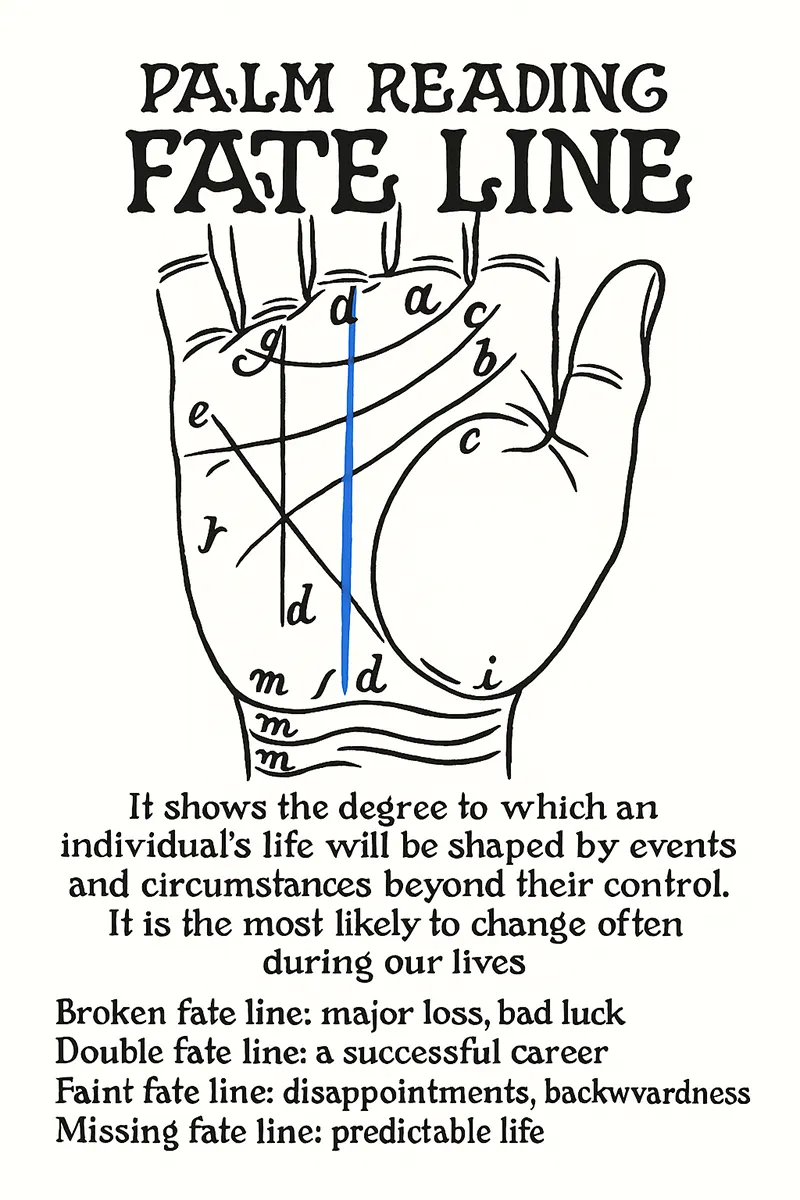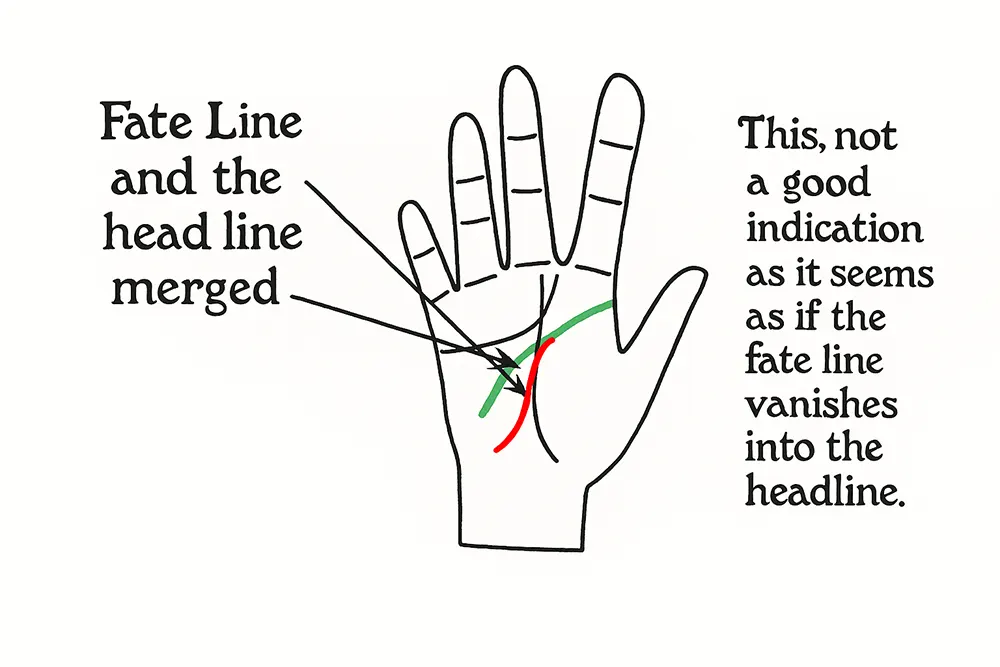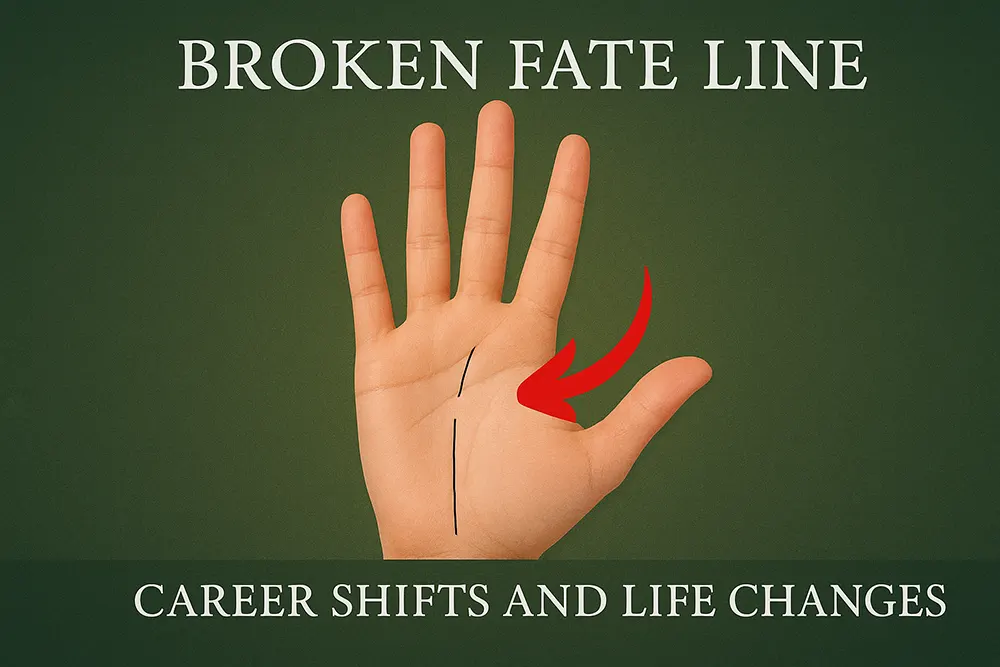Have you ever glanced at your palm and wondered what those intricate lines reveal about your journey through life? In the ancient art of palmistry, also known as chiromancy, the lines on our hands are believed to map out our destiny, personality, and potential challenges. Among these, the fate line stands out as a profound indicator of one’s career path and major life transitions. But what happens when this line is broken? Does it signal doom, or could it be a sign of exciting reinvention? In this comprehensive exploration, we’ll delve deep into the broken fate line, uncovering its meanings related to career shifts and life changes, while providing practical insights to help you interpret your own palm.
Palmistry has fascinated humanity for centuries, offering a window into the soul through the simple act of examining one’s hands. Whether you’re a skeptic or a believer, understanding the broken fate line can provide valuable perspectives on adapting to change in an ever-evolving world.
The Foundations of Palmistry: A Brief Overview
Before we zoom in on the fate line, it’s essential to grasp the basics of palmistry. This practice dates back to ancient civilizations, including those in India, China, and Egypt, where it was used to predict fortunes and guide decisions. The palm is divided into major and minor lines, each associated with different aspects of life. The three primary lines are the heart line (emotions and relationships), the head line (intellect and mindset), and the life line (vitality and life events). Secondary lines, like the fate line, add layers of detail, particularly concerning external influences and personal destiny.
Palmistry isn’t just about reading lines; it involves considering the hand’s shape, mounts (the fleshy pads), finger lengths, and even skin texture. For instance, a square hand might indicate practicality, while a conical one suggests creativity. These elements interplay to form a holistic reading. In modern times, palmistry blends with psychology, where lines are seen as reflections of subconscious patterns rather than rigid predictions. This fusion makes it relevant today, helping individuals reflect on their life choices amid uncertainty.
Historically, palmistry evolved from Vedic astrology in India, where it’s called “hast rekha” or hand lines, and spread to Europe during the Middle Ages. Renowned figures like Aristotle reportedly studied it, believing hands revealed character. Today, it’s practiced worldwide, from street-side readers in Asia to professional consultants in the West. While science dismisses it as pseudoscience, proponents argue it encourages self-awareness and proactive life management.
Decoding the Fate Line: Its Role in Your Palm
The fate line, often called the line of destiny or career line, typically runs vertically from the base of the palm near the wrist up toward the middle finger (Saturn finger). Not everyone has a prominent fate line; its absence or faintness can indicate a life driven by free will rather than predetermined paths. When present, it symbolizes the trajectory of your professional life, luck, and major milestones influenced by external factors.
A strong, unbroken fate line suggests a stable career with steady progress, perhaps in a single field where dedication yields success. It might start from various points: the wrist for early ambition, the life line for family-influenced paths, or the head line for mid-life career awakenings. The line’s depth, length, and clarity matter—a deep one implies strong determination, while a wavy one hints at indecision or frequent adjustments.
In palmistry, the fate line intersects with other lines, creating unique stories. For example, if it merges with the head line, it could mean intellectual pursuits dominate your career, like in academia or innovation. Branches or islands on the line add nuances: upward branches signal promotions, downward ones potential setbacks. Timing is estimated by dividing the line into segments—lower for youth, middle for adulthood, upper for later years—allowing readers to pinpoint when changes might occur.
Culturally, in Chinese palmistry, the fate line is linked to “ming” or destiny, emphasizing harmony with cosmic forces. In Indian traditions, it’s “bhagya rekha,” believed to reflect karma and efforts. Understanding this line helps individuals align their actions with inherent potentials, turning palm reading into a tool for personal growth.

What Constitutes a Broken Fate Line?
A broken fate line appears as discontinuous segments, with gaps or overlaps, rather than a seamless stroke. These breaks can be small or significant, single or multiple, and their positions reveal the timing of disruptions. Unlike a faint line, which might indicate low energy periods, a true break suggests abrupt interruptions.
To identify it, examine your dominant hand (right for right-handers) under good light. The break might be a clean gap, where the line stops and restarts nearby, or fragmented with scattered pieces. Sometimes, a parallel line runs alongside, indicating recovery or alternative paths. Factors like hand flexibility can influence visibility—stiff hands might show more rigid lines, while flexible ones indicate adaptability.
Breaks often correlate with life stages: a lower break might relate to early career hurdles, like education interruptions, while an upper one could point to late-life transitions, such as retirement challenges. It’s crucial to note if the line resumes stronger after the break, symbolizing resilience and growth from adversity.
Interpretations of the Broken Fate Line: Career Shifts Unveiled
In the realm of career, a broken fate line is a powerful symbol of transformation. Rather than foretelling failure, it often indicates pivotal shifts—job changes, industry switches, or entrepreneurial ventures. For instance, if the break occurs around the head line (mid-palm), it might signify a mid-career crisis, prompting a move from corporate stability to creative pursuits.
Consider a scenario: A young professional with a break in the lower fate line might experience early job instability, like layoffs during economic downturns, but if the line continues upward, it suggests rebounding with greater success. Multiple breaks could mean a versatile career, such as freelancing or serial entrepreneurship, where adaptability is key.
From a psychological angle, these breaks encourage self-reflection. In today’s gig economy, where average job tenure is short, a broken fate line mirrors the norm rather than an anomaly. It prompts questions like: Are you in a role that fulfills you? What skills can you pivot to? Success stories abound—think of Steve Jobs, whose palm (hypothetically) might show breaks reflecting his ousting from Apple and triumphant return.
Detailed variations include:
- Short Breaks: Minor adjustments, like promotions with role changes.
- Overlapping Segments: Smooth transitions, where old and new careers blend.
- Breaks with Branches: Opportunities arising from disruptions, such as networking leading to better positions.
- Faded After Break: Periods of uncertainty, requiring skill-building.
By interpreting these, individuals can prepare for shifts, perhaps by upskilling or networking, turning potential obstacles into stepping stones.
The Broken Fate Line and Broader Life Changes
Beyond careers, the broken fate line speaks to holistic life alterations—relocations, relationships, health events, or spiritual awakenings. A break intersecting the life line might link to health issues affecting destiny, while one near the heart line could tie to emotional upheavals influencing paths.
Life changes indicated might include moving countries for work, which reshapes identity, or family events like marriage/divorce altering priorities. In spiritual palmistry, breaks represent karmic lessons, urging growth through challenge. For example, a break in mid-life could coincide with a “second act,” like pursuing passions post-childrearing.
Culturally, in Western palmistry, it’s seen as fate’s intervention, while Eastern views emphasize effort to mend “broken” destiny. Modern interpretations frame it positively—as evolution. Think of it as life’s plot twists, adding depth to your story.
To navigate these:
- Reflect on past changes: How have they shaped you?
- Plan for resilience: Build savings, networks.
- Embrace flexibility: View breaks as invitations to reinvent.
Variations and Nuances in Broken Fate Lines
The broken fate line isn’t one-size-fits-all; variations add richness. A chained break (series of small links) suggests ongoing minor disruptions, common in creative fields. If broken but supported by a strong sun line (fame line), it indicates recovery through talent or recognition.
Position matters: Base breaks point to foundational shifts, like changing majors in college; apex breaks to late-career pivots. Gender differences? Some traditions note women’s lines change more post-life events, but this is anecdotal.
Other signs: Islands post-break signal temporary confusion, crosses indicate obstacles overcome. Comparing both hands—left for potential, right for reality—reveals how choices alter fate.

How to Accurately Read Your Broken Fate Line
Reading your palm requires patience. Start in natural light, relax your hand. Trace the fate line, note breaks’ locations using age markers (wrist=0, head line=35, heart line=50 approx.).
Tools: Magnifying glass for details, journal to track changes—lines evolve! Consult experts for complex readings, but self-study builds intuition.
Common mistakes: Ignoring context (other lines), over-literal interpretations. Remember, palmistry guides, not dictates.
Real-Life Case Studies: Stories from the Palm
Consider Sarah, a teacher with a mid-palm break: She switched to writing after burnout, finding fulfillment—her line “resumed” stronger. Or Mike, entrepreneur with multiple breaks: Each gap marked failed startups, but led to his successful app.
Historical figures: Einstein’s palm might show breaks reflecting academic struggles before breakthroughs. These anecdotes illustrate breaks as catalysts.
Embracing the Messages: Strategies for Positive Change
A broken fate line invites proactive steps. Career-wise, explore passions via courses. For life changes, practice mindfulness to handle transitions. Affirmations like “I adapt and thrive” reinforce positivity.
Seek support: Coaches, therapists integrate palm insights with practical advice. Ultimately, view breaks as opportunities for growth.
The Skeptical Lens: Palmistry in the Modern World
While enchanting, palmistry lacks empirical evidence; lines may result from genetics or usage. Yet, its value lies in introspection, much like journaling. Balancing belief with reason enhances its utility.
Frequently Asked Questions About the Broken Fate Line
What does a broken fate line really mean?
It typically signifies disruptions or changes in career and life, but often leads to positive reinvention rather than permanent setbacks.
Is a broken fate line a sign of bad luck?
Not necessarily; many see it as temporary challenges that build character and open new doors.
Can the fate line change over time?
Yes, palms evolve with life experiences, so lines can deepen or alter, reflecting personal growth.
What if my fate line is broken multiple times?
This suggests a dynamic life with frequent adaptations, common in versatile careers.
Does a broken fate line indicate accidents?
In some interpretations, yes, especially if abrupt, but it’s more about general obstacles.
How can I strengthen a weak or broken fate line?
Through focused efforts like goal-setting and perseverance; some believe gemstones like sapphire help.
What if there’s no fate line at all?
It implies a self-directed life, free from rigid destiny, emphasizing free will.
Does the broken fate line differ between hands?
The left shows innate potential, right actual path; discrepancies highlight choices made.
Can palmistry predict exact career changes?
It offers general timing and themes, not specifics; use it as guidance.
Is palmistry accurate for everyone?
Accuracy varies; it’s interpretive and subjective, best used for reflection.
Wrapping Up: Your Palm as a Map to Resilience
The broken fate line, far from a curse, is a testament to life’s fluidity. By understanding its messages on career shifts and life changes, you empower yourself to navigate with grace. Whether through self-reading or professional consultation, let your palm inspire a journey of continuous evolution. Remember, destiny is in your hands—literally.
